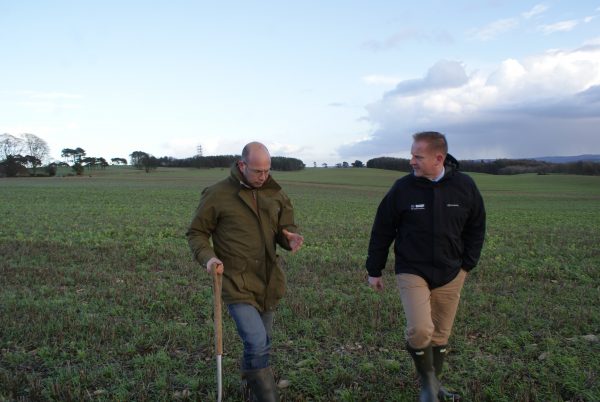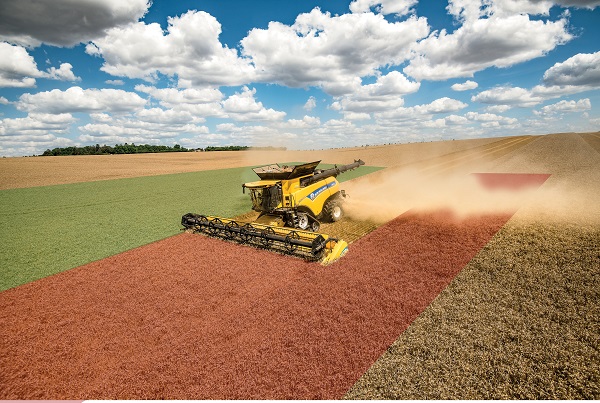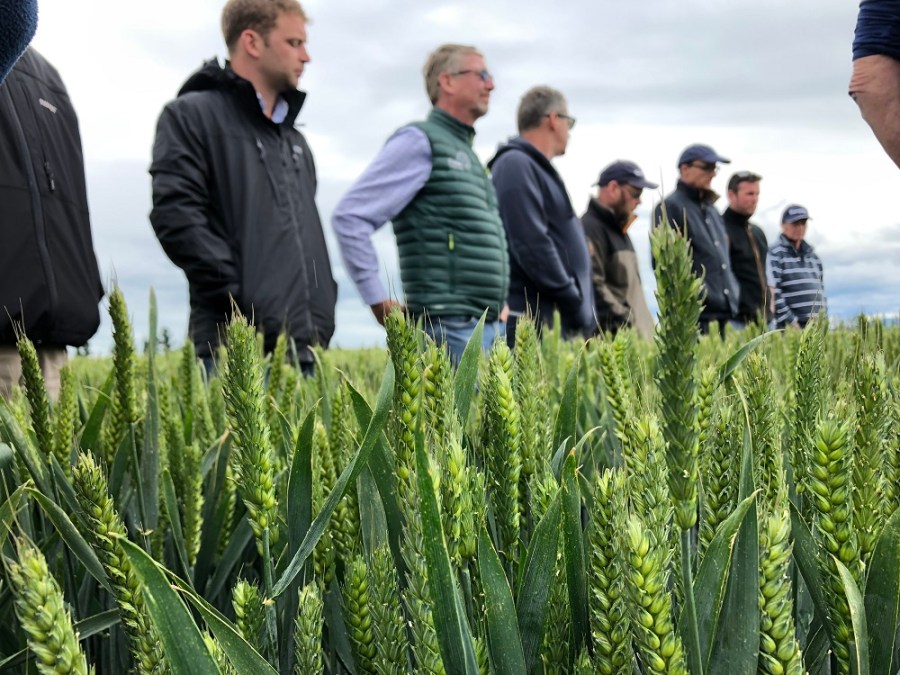Since 2017, a group of 50 farmers have been putting BASF’s Xemium fungicides through a pioneering on-farm trials programme. There are now some Real Results, but they’re not what you might expect, as CPM discovers.
The purpose of Real Results is to cut through the variability of the blunt tool that is a field-scale trial.
By Tom Allen-Stevens
Ask one of the 50 Real Results farmers whether the BASF fungicide programme has outperformed their farm standard and you’ve probably missed the point of Real Results altogether.
“The purpose of Real Results is to cut through the variability of the blunt tool that is a field-scale trial,” notes BASF’s Tim Short, who’s co-ordinated the campaign.

BASF learns as much about how its innovations are used in practice as farmers are understanding how to get the best out of them.
“So much in farming comes down to making the right decision, and few decisions are more important than fungicide choice and timing. But unlike other farm comparisons, Real Results gives power to on-farm decision-making, and that’s a massive point of difference that gives confidence in the findings.”
Key to this has been understanding where variation comes from in a field trial and the need to reach a valid result for proper comparison. “It’s also about a group of farmers learning together and discovering new ideas. Real Results gives farm-level answers to the questions growers have, and a platform to test innovation.”
The Real Results Circle started in 2017 to put into practice a pioneering new way of conducting on-farm trials. “We have confidence in the Adexar/Librax programme – we’ve taken it through exhaustive internal trials as we developed the chemistry,” he continues.
“Real Results is where practical action meets the innovation. It’s designed to give farmers the same confidence in the fungicide technology they’re using on their farms, whether that’s the Ad/Lib approach, a competitor industry standard or their own programme they’ve developed to fit their individual requirements.”
Tim recognises that, in many cases, these programmes can add up to a considerable investment in fungicide. While few growers would consider leaving crops untreated, most would want to be able to justify any money spent and be confident that a programme’s performing at its best, he says. So there are two key principles that are put to the test:
- The value of the chemistry used
- How it’s used at a field scale
“It’s not just about what the farmer learns on their own farm. The essence of Real Results is that it’s a two-way voyage of discovery – we’re learning as much about how our innovations are used in practice as farmers are understanding how to get the best out of them. That helps us shape new technologies and future solutions,” notes Tim.

The ADAS team split each in-field trial area into small plots, and then analyse the results along the intersection where the treatments under scrutiny meet.
What makes Real Results unique among on-farm fungicide trials is that the programme uses ADAS’ Agronomics protocols, including robust analysis of the results. Using the yield map generated by the combine, the ADAS team assess the patterns in the thousands of yields recorded and work out the likelihood that any differences between treated areas were due to the treatments, rather than inherent soil effects.
“This puts the same rigour into field-scale trials that you get from small, replicated trial plots. Taking out any differences in the results attributable to in-field variation means the result you get from the trial is ‘real’,” he says.
In practice the variation across fields has been high in some instances, he notes, to the extent that some treatment differences are too uncertain to trust – that means the variation across all the data points is such that ADAS analysts say the difference is just as likely due to the treatment as to natural in-field variation.
“All of the farmers also measure the overall difference over a weighbridge, and we’ve had a couple of instances where the weighbridge results differ from the Real Results. On one farm, the weighbridge showed a 0.6t/ha difference from one of the treatments, but the ADAS analysis showed there was actually no difference at all. If it hadn’t been for Agronomics, the farmer could have drawn the wrong conclusion.”
Tim stresses that each result is unique to each farm, and it would be up to each individual farmer what conclusion they draw. “Having said that, looking across the results, there are observations you can make.”
Overall the Ad/Lib approach has performed as well as the farm standard treatments pitched against it. “This includes newer chemistry and where growers have tailored their standard farm programme to match the season – the Ad/Lib standard remains the same across all 50 farms,” he notes.
“It’s also worth noting that in a lot of cases, Xemium fungicides have also been included in the standard farm programme, so it’s maybe not surprising that differences are small.” Last year’s drought has also skewed results, he adds, with few crops benefiting from a full growing season, while disease levels have been low across both years of the campaign.
One trend that has been coming through is the value of two SDHIs in the spray programme, he says. “Generally all the spray programmes are robust, but some rely on triazole-based chemistry alone at the T1 timing. The results suggest such an approach is no longer doing the job required.”
Such observations only touch the surface of the Real Results that are now coming through from the campaign. For Dr Daniel Kindred of ADAS, who pioneered Agronomics, it’s been a valuable application of this powerful approach to on-farm trials.
“Real Results has been a very useful proof of concept. BASF has been involved with our Agronomics approach right from the start, and the Ad/Lib fungicide programme has been an ideal application to see how it plays out in practice,” he says.
“What it’s now unearthing is a real insight into managing the huge variation in yields across UK farms – we are starting to understand how we can lift wheat performance off the yield plateau.”
Research in this area started with the Auto-N project, a joint Defra and industry-funded programme that ran from 2010-15 designed to determine better how in-field variation influences optimum N applications. “This quantified for the first time the scale of the yield differences you get in a field attributable to the soil,” explains Daniel. “It’s usually far greater than you can address through an input such as fertiliser or fungicide.”
This provided the reason for the Agronomics research project, that ran from 2013-17 and was funded by Innovate UK, in which BASF, AgSpace, the British Geological Society, VSNi and Trials Equipment were partners, along with ADAS. “We wanted to develop a process which could make agronomic research more farm-specific, while still being statistically robust.
“Our hope was that tramline trials could be carried out using existing farm equipment, and then we could somehow use GPS information to work out whether we should trust the tramline differences,” says Daniel.
Thousands of data points from combine yield monitors were used to assess patterns of variation, and to work out how yields either side of the boundary line between treatments could be related to underlying spatial variation. “Farmers are often interested in quite small yield effects so, once we had found how to compare differences within yield maps, we decided to report the degree of certainty in differences being ‘real’, even if they are quite small” he explains.
The Agronomics approach is now an industry standard for delivering on-farm research that has a sound scientific basis that can be carried out by farmers. It’s being used across more 150 on-farm trials this year, of which many are carried out by the Real Results Circle.
So what lessons have been learned over the past two years in how to maximise confidence in the results? “We always advocate using an area within the middle of the field, to eliminate variations associated with headlands. It’s best if you can replicate the tramlines, so span the trial over four or six bout widths, rather than just two,” says Daniel.
How the area is harvested can also have a significant effect – it’s best to maintain a full header width as much as possible. The tramline wheelings themselves can also bring about a big difference between the treatment areas that can throw the results. Daniel notes that farmers on a controlled traffic farming system generally have a harvest discipline that’s ideally suited to getting the best trial results.
“It’s only patterns of in-field variation that Agronomics can account for,” he adds. “Random variations in spots and small patches within the treatment areas have to be discounted, so they can seriously reduce confidence in the results.”
The surprise result has been the farmer involvement, however. “Our biggest concern has been getting a good rate of return on full datasets from the farmers involved, and that’s exceeded expectations – indeed, the quality and quantity of reliable data have both improved. What we’re now finding is that farmers are looking beyond the results themselves to what lies behind them.”
And Daniel believes it’s through understanding the underlying spatial variation that will unlock the real secrets of yield enhancement. “Real Results exposes lots of variation with big associated uncertainties. We want farmers to own these uncertainties – use them as the basis for improving their on-farm thinking and decision making.”
This is what drives the two-way relationship between scientist and farmer, he explains. Scientists are trained to admit their uncertainties, so they should be able to help those farmers who can admit theirs make better decisions. That requires scientists with a level of pragmatism and farmers equipped with robust data with which to engage with scientists.
“Real Results is one of the first exercises to provide just that – this is the hidden value underlying the campaign. BASF has really helped us towards addressing the really big challenge that lies at the heart of farming.”
This arises from the estimated trillion, trillion (1030) options that farmers face in bringing an agricultural product or outcome to market. Daniel calls this the Agronome, a huge arena which arises from the combined effects of three forces:
- Genetics – everything inherent about the plant, which he argues is the factor most explored by science and about which we have a relatively good understanding.
- Environment – everything to do with the weather, pests, diseases and soil that act on the plant, some of which we have a good understanding, but where a lot of knowledge gaps still lie, and where there is a lot of local variation.
- Farm Management – this includes agronomy, but also the ‘farmer factor’ that causes variation between farms and fields that can’t be explained by genetics, environment nor even by agronomic inputs, and about which we know the least.
“All the on-farm variation that exists should be explicable by these three forces, and science could be applied that would improve decision making – both strategies and tactics – that should enable farmers to achieve higher yields and more sustainable farming systems,” he says. “What Real Results has proven is that we can do this and that farmers are really receptive to the process that can deliver it.”
Like Daniel, Tim’s struck by the level of farmer engagement in Real Results. “Within the group, those involved have been really keen to do the trials properly. To get the most out it requires a considerable investment in time and thought, and it’s a credit to the individuals involved that they’ve delivered that.”
A measure of this came earlier this year, when the Real Results farmers came together to discuss the results. “We allocated half an hour for a coffee break, but the conversations the farmers were having were so good, it lasted over an hour. We’re finding the community aspect – giving farmers the space and the opportunity for these conversations – is delivering a value you can’t quantify, but you can tell it’s significant,” notes Tim.
“It’s also broadening horizons for BASF – we’ve learnt so much from this group of farmers, and we didn’t expect it to happen to this extent. This is how we can work together to address challenges such as moving forwards without chlorothalonil, new fungicide chemistry introductions, and adjusting timings and dose rates to address stewardship issues.
“Looking further afield, the BASF innovation pipeline is looking really good. To my mind, there’s no better way of keeping that focused on the grower than to bring those innovations first to the Real Results farmers.”
Scan the can and take a tour
After the successful innovation tour to New Zealand in 2018, BASF has announced growers using Adexar (fluxapyroxad+ epoxiconazole) and Librax (fluxapyroxad+ metconazole) will have a chance to win one of 40 places on a 5-day trip to Germany in Nov, incorporating Agritechnica.
Including an exclusive visit to the BASF research and development centres, farmers will have a chance to look at their seed breeding and on-farm trials with the new cereal fungicide, Revysol.
To be eligible for the innovation tour, download an app to log product purchased by scanning QR codes on the side of each can. Those buying over 150 litres of Adexar or Librax will be entered into the prize draw to join the trip.
Lincs grower Tim Beaver won a place on the 2018 innovation tour to New Zealand. “The Scan the can app was very easy and straight forward to use,” he says.
“BASF wants farm businesses to be sustainably profitable in the long term and they’ve invested in helping, supporting and advising us. The innovation tour was key to this programme, looking at all aspects of our farm businesses and not just focusing on the chemical side.”
Farmers could also win one of 100 pairs of Meindl Burma Pro walking boots, and everyone who enters will receive a Petzel Tikkina headtorch.
To get involved, download the app at www.basfrealresults.co.uk
The Real Results Circle
BASF’s Real Results Circle farmer-led trials are now in their third year. The initiative is focused on working with 50 farmers to conduct field-scale trials on their own farms using their own kit and management systems. The trials are all assessed using ADAS’ Agronomics tool which delivers statistical confidence to tramline, or field-wide treatment comparisons – a unique part of Real Results.
In this series we follow the journey, thinking and results from farmers involved in the programme. The features also look at some in-depth related topics, such as SDHI performance and data capture and use.
We want farmers to share their knowledge and conduct on-farm trials. By coming together to face challenges as one, we can find out what really works and shape the future of UK agriculture.
To keep in touch with the progress of these growers and the trials, go to www.basfrealresults.co.uk




